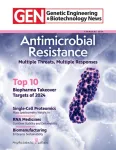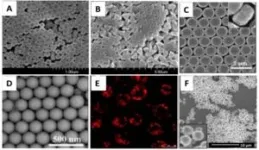(Press-News.org) Recent breakthroughs in spatial biology technology have transformed biomedical research; however, legal disputes are preventing small, innovative companies from advancing new technologies and ideas. Ongoing litigation poses a threat to the progress of even the most promising scientific technologies and the potential discoveries they could enable, according to the authors of the exclusive article titled “Sounding an Alarm Over Spatial Biology,” in Genetic Engineering and Biotechnology News (GEN). Click here to read the article now.
Miranda Orr, PhD, from Wake Forest University School of Medicine, and coauthors, issued an urgent call for antitrust measures. “The ongoing litigious environment has negatively impacted competitive progress and we are concerned about the potential emergence of monopolistic behavior that could hinder innovative patient care,” state the authors.
The current litigious atmosphere is driving the closure of promising companies and discouraging emerging companies with groundbreaking solutions in spatial biology from patenting and publicizing their innovations for fear of sparking a lawsuit.
“Patent and other legal battles have been given in biotechnology ever since the industry’s early years,” says GEN Editor-in-Chief John Sterling. “The continual litigation in this rapidly advancing area of spatial biology recently caused one of the major players, NanoString Technologies, to file for bankruptcy.”
About Genetic Engineering & Biotechnology News (GEN)
About the Publisher
Mary Ann Liebert, Inc. is a global media company dedicated to creating, curating, and delivering impactful peer-reviewed research and authoritative content services to advance the fields of biotechnology and the life sciences, specialized clinical medicine, and public health and policy. For complete information, please visit the Mary Ann Liebert, Inc. website.
END
Urgent call for antitrust measures to safeguard innovation in spatial biology
2024-02-09
ELSE PRESS RELEASES FROM THIS DATE:
Pre-diabetes gets its due: New $1.2 million award aimed at early intervention and treatment
2024-02-09
SAN ANTONIO, Feb. 8, 2024 – More than one out of three people have pre-diabetes, characterized by abnormal blood sugar levels not yet in the diabetes range – and yet associated with significant increases in eye, kidney and neuropathic diseases, and risk of cardiovascular death.
Moreover, the number of people with the condition is expected to double by 2030, with prevalence substantially higher in minority populations, including Hispanics. Both pre-diabetes and diabetes are considered global epidemics.
As pre-diabetes largely is underdiagnosed and undertreated, ...
Celebrating excellence in anatomy: AAA awards distinguished members
2024-02-08
ROCKVILLE, MD – February 8, 2024 – The American Association for Anatomy (AAA) is honored to announce its 2024 awards recipients. Eighteen of the association’s 2,455 members have been selected because they advanced AAA’s values: community, respect, inclusion, integrity, and discovery.
The AAA awards program provides over $650,000 in awards, research grants, and scholarships annually. Many recipients go on to achieve significant success in their careers.
"We, as anatomy ...
Athira Pharma announces publication in Frontiers in Neuroscience highlighting therapeutic potential of ATH-1105 in amyotrophic lateral sclerosis (ALS)
2024-02-08
BOTHELL, WA, Feb. 8, 2024 — Athira Pharma, Inc. (NASDAQ: ATHA), a late clinical-stage biopharmaceutical company focused on developing small molecules to restore neuronal health and slow neurodegeneration, today announced publication of research highlighting the neuroprotective and anti-inflammatory effects of ATH-1105 in preclinical models of amyotrophic lateral sclerosis (ALS). The original research article, “ATH-1105, a small-molecule positive modulator of the neurotrophic HGF system, is neuroprotective, preserves neuromotor function, and extends survival in preclinical models of ALS,” authored by Berthiaume, A., and Reda, S., et al., was published ...
Sex hormones help gonorrhea fight off antimicrobials and antibiotics
2024-02-08
DURHAM, N.C. – You know that package warning that oral birth control won’t prevent STIs? Well in the case of gonorrhea, the sexually transmitted bacterium that causes the disease can use those hormones to help it resist antibiotic attacks.
Like many bacteria, this bug, Neisseria gonorrhoeae, is equipped with pumps to push the killing chemicals out of its cells. But what’s unique, according to a Duke and Emory study online this week in Nature Communications, is that the hormones of the human urogenital tract actually allow gonorrhea to make and use more of these pumps to fight intrinsic ...
45 finalists named for the 2024 Hertz Fellowships
2024-02-08
The Fannie and John Hertz Foundation today announced 45 finalists for the 2024 Hertz Fellowships in applied science, mathematics and engineering.
Selected from more than 860 applicants and representing 21 universities, the finalists advance to a culminating round of interviews for one of the most competitive and coveted doctoral fellowships in the nation. The 2024 class of Hertz Fellows will be announced in May.
Since 1963, the Hertz Foundation has granted fellowships empowering the nation’s most promising young ...
How one type of lung cancer can transform into another
2024-02-08
Lung tumors called adenocarcinomas sometimes respond to initially effective treatments by transforming into a much more aggressive small cell lung cancer (SCLC) that spreads rapidly and has few options for treatment. Researchers at Weill Cornell Medicine have developed a mouse model that illuminates this problematic process, known as histological transformation. The findings advance the understanding of how mutated genes can trigger cancer evolution and suggest targets for more effective treatments.
The researchers, whose results were published ...
Results from South Pole Telescope’s new camera emerge
2024-02-08
Argonne is part of a multi-institutional effort to survey the sky for clues about the origins and nature of our universe.
For more than five years, scientists at the South Pole Telescope in Antarctica have been observing the sky with an upgraded camera. The extended gaze toward the cosmos is picking up remnant light from the universe’s early formation. Now researchers have analyzed an initial batch of data, publishing details in the journal Physical Review D. The results from this limited dataset hint at even more powerful future insights about the nature of our universe.
The telescope at the Amundsen-Scott South Pole Station, which is operated by the National ...
Rosenthal Department of Management established at McCombs School of Business
2024-02-08
AUSTIN, Texas — The Management Department in the McCombs School of Business at The University of Texas at Austin has long been recognized as a powerhouse for research excellence and teaching innovation. Now, it holds a new distinction. It is the first academic department in the business school to be named as the result of a generous gift.
The newly named Rozanne and Billy Rosenthal Department of Management has been made possible by a $25 million gift from two married Longhorns, Rozanne Rosenthal, B.S. ’74, and Billy Rosenthal, BBA ’72. ...
Professor of Finance named ECGI Fellow
2024-02-08
AUSTIN, Texas -- In recognition of her research and scholarship, Laura Starks, a professor of finance at The University of Texas at Austin, was recently named a fellow of the European Corporate Governance Institute (ECGI). She is among eight new fellows selected from academia in Europe and the United States. ECGI, founded in 2002, is an international scientific nonprofit association that serves as a forum on corporate governance among academics, legislators, and practitioners.
Starks is the George Kozmetsky Centennial University Distinguished Chair in the McCombs School of ...
NJIT researchers unveil method to detect 'forever chemicals' in under 3 minutes
2024-02-08
PFAS have earned the name “forever chemicals” with good reason — the man-made compounds, which can take thousands of years to degrade and are found in everything from grease-resistant food packaging to water-repellent clothing, have made their way into nearly half the U.S. tap water supply.
Now, in a study featured in Elsevier’s Journal of Hazardous Materials, New Jersey Institute of Technology chemists have demonstrated a new lab-based method to detect traces of PFAS from food packaging material, water and soil samples in just three minutes or less.
Researchers say their approach could ...







